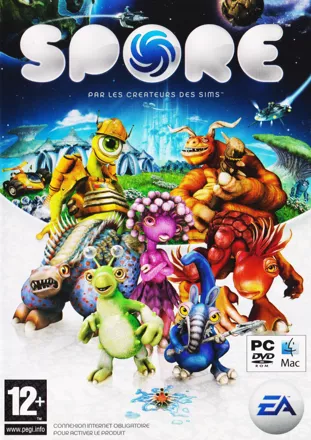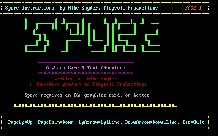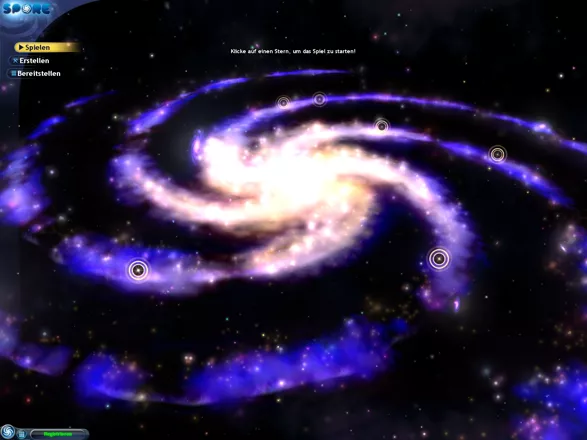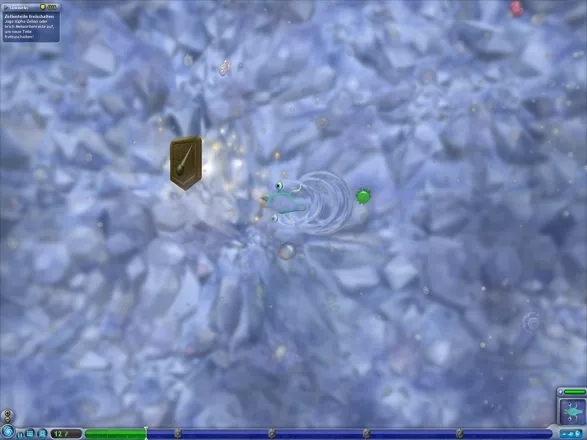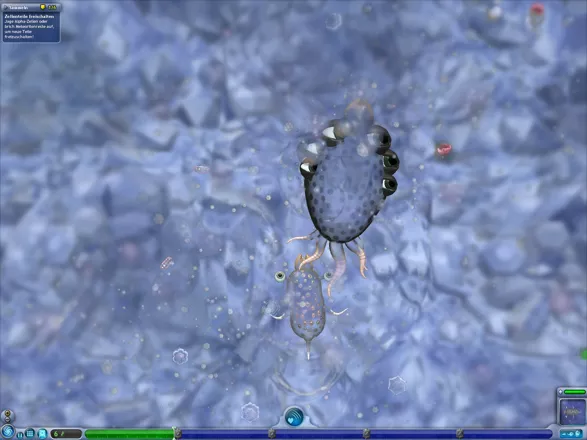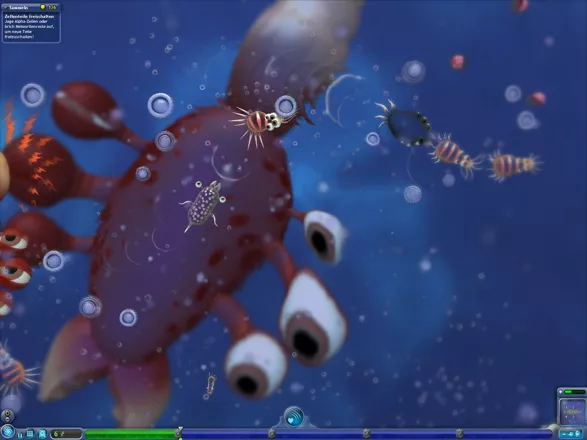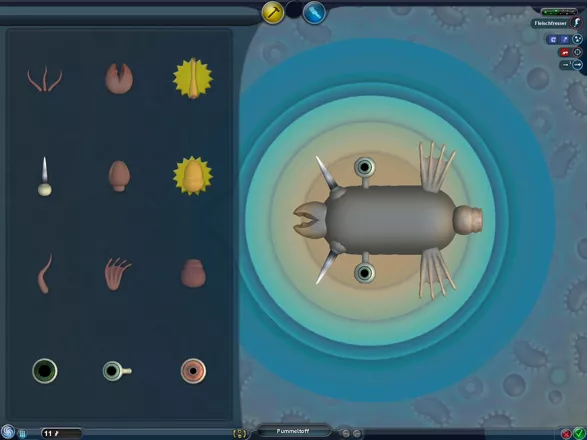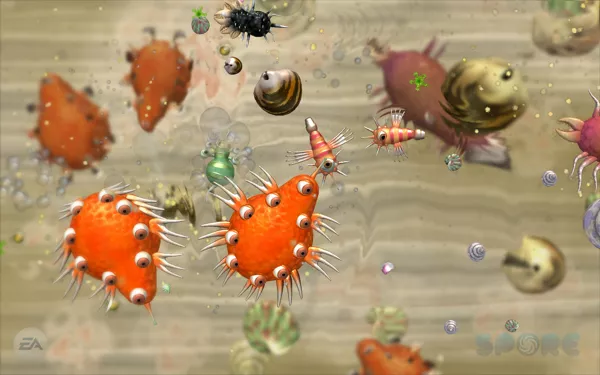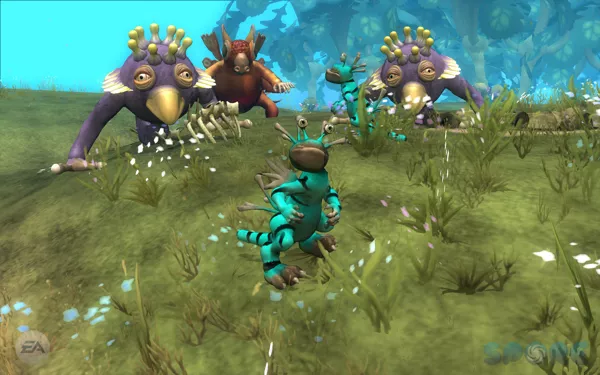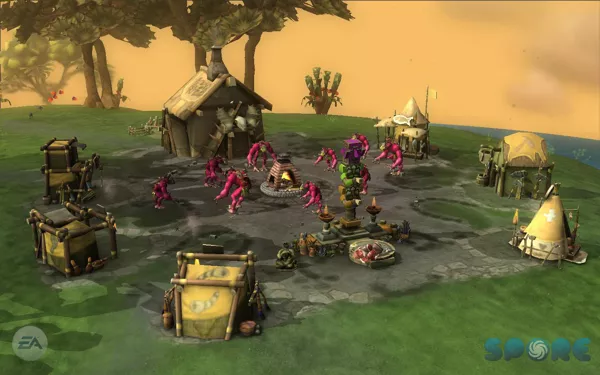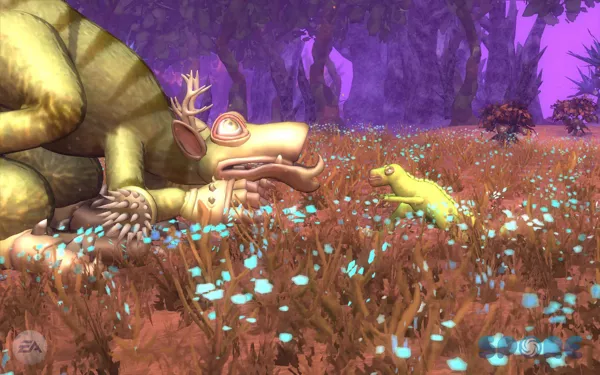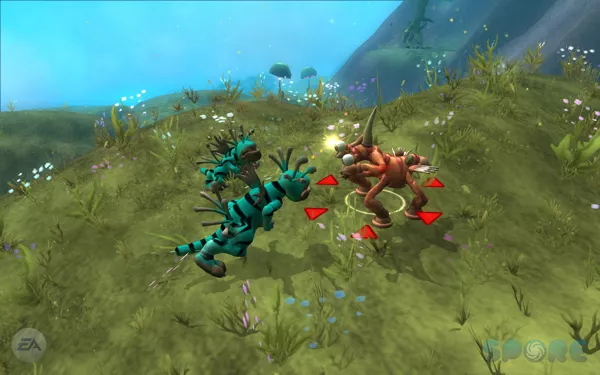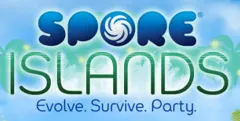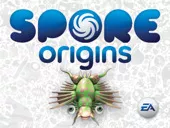Spore
Description official descriptions
In Spore the player has to accompany a new race through five stages of its evolution.
First there is the Cell Phase: From a top-down view the goal is to eat meteorite parts floating in the primordial soup to gain DNA points. But the player's creature is not alone and other, friendly or not-so-friendly organisms float about. If the player kills other alpha organisms, he unlocks a new part for the creature editor like a new mouth. These parts all give the player's creature different abilities including singing or a better attack and even affect what the creature can eat. As the player collect's DNA points, the creature grows and moves up into a higher layer of the primordial soup until he is big enough to advance to the next stage: the creature phase.
At the beginning of the Creature Phase the player needs to redo his creature in the creature editor with a new set of parts like feet or hands. Then the goal is again to collect DNA points by roaming the land and befriending or killing the other inhabitants. Again there can be additional parts for the editor found which are dropped by alpha creature that get killed either by you or other, bigger creatures. If the player chooses not to attack but rather talk to the other races, he needs to gain their trust by following their lead and doing what they do. While the lowest creatures see you as a friend already when you just sing with them, more advanced races require a high level in dancing and other abilities which are again gained by rebuilding the creature in the editor with the gained DNA points and available parts. Once the player has collected enough DNA points and developed a certain level of intelligence by doing so, he can enter the Tribes Phase.
From now on the player can't change the basic anatomy of the creature but instead has access to the tools and clothing editors. The game also plays more like an RTS from now on, requiring to control a group of creature instead of just one and building up a village. Interaction with the other tribes, defending the village and collecting food are the main goals in this phase. Once the player has conquered or allied himself with five other tribes, he can enter the Civilization Phase.
Now the player has access to the building and vehicle editors to further specialize his former tribe and become the ruling civilization on the planet. The basic gameplay and controls remain the same as in the tribes phase but by conquering or befriending other nations, the player's civilization now gets access to new technologies - including the one required to enter the fifth, last and longest phase of the game: the Space Phase.
With his ship, the player now needs to go out and colonize or conquer the whole galaxy, defend his own planet against other space faring nations and supply his race with enough food.
The game doesn't have a real multiplayer. Instead the planets are populated by creations that other players made in their game. The players can choose to upload their creatures and even the whole planet to the online database called Sporepedia and from there they get distributed to everyone. Once downloaded, the AI takes over the control of these creatures and advances them further.
Groups +
Screenshots
Promos
Videos
See any errors or missing info for this game?
You can submit a correction, contribute trivia, add to a game group, add a related site or alternate title.
Credits (Windows version)
531 People (499 developers, 32 thanks) · View all
| Software Engineer, Audio | |
| Software Engineer, Core Engine & Graphics Systems & Pipelines | |
| Producer, Animation & Art | |
| Lead Engineer, Audio | |
| Lead Engineer, Pollination | |
| Lead Designer, Gameplay | |
| Software Engineer, Gameplay | |
| [ full credits ] | |
Reviews
Critics
Average score: 81% (based on 81 ratings)
Players
Average score: 3.6 out of 5 (based on 84 ratings with 3 reviews)
The Good
When asked about his inspirations for Spore by German game review magazine GameStar, Will Wright listed the short film "Power of 10", an impressive zoom out of a picnic scene to a distance of ten million light years and back to a magnification of 0.00001 ångström. Current evolution theories and their alleged imprint on the game concept aside, the scale concept behind "Power of 10" perhaps describes Spore's core game idea best.
Stretching over five game phases, players of Spore influence an entire species' development from single cell organism to a galactic civilization. Not only does Spore roughly chronicle the mechanisms which modern science assumes cause the evolution of life, it also plays like a light-hearted ramble through the history and evolution of computer games.
Starting in single cell phase, Spore reduces the game to the simplest of conflicts: eat or be eaten. An arcade experience à la Pac-Man, another core game element that is introduced in this early stage is the customization of the organism using the game's amazingly flexible and easy to use 3D anatomy editor. Customization grants the organism advantages like enhanced speed, strength or manoeuvrability but must be paid for by spending DNA points which in turn are amassed by ingesting the life form's chosen diet. As soon as the life form grows to a certain size and has to leave its original habitat, the primordial soup, the palette of available body parts with which the organism can be outfitted is enhanced. While the newly-born land organisms goal of survival remains the same, means to this end become a little more complex as social interaction and more sophisticated defence and hunting mechanisms become available. Although players still control an individual organism, the game's Creature Phase plays like an action-RPG. The game's third phase, Tribal, finally sacrifices control over an individual organism, turning into a real-time strategy game. Spore now makes players mobilise an entire community to gather resources and defeat or assimilate competing life forms' tribes. As Spore enters Civilization phase and treats players to a severely simplified version of the eponymous series of strategy games, the conflict becomes cultural rather than interracial - having conquered their habitat, creatures now fight among themselves for living space and resources. Space Stage, the game's final phase, opens up the whole galaxy to players and broadens their view of all preceding phases. From a life form's humble beginnings as a cell to their physical development during Creature Stage, social achievements during Tribal Stage and cultural evolution during Civilization Stage, Space Stage allows the life form to finally realise the larger scope of the universe it lives in and use its knowledge to shape the destiny of creatures less advanced. It is also during Space Stage that Spore as a game makes the possibilities of its in-built online community fully available, automatically loading other players' creations into the game.
The heart and soul of Spore is its editor, granting players an unprecedented level of customisation in a game. The technical achievement is truly remarkable because design elements and animation work together as flexibly as in no other game before it. Spore still manages to maintain its own style of presentation, a strangely perfect balance of customisability and character.
The Bad
Spore is a casual game in all respects as neither its complexity nor its purported "scientific-ness" are as deep as its creators like to believe. Although basic scientific theories and mechanisms are illustrated, those aspects remain, while not shallow, crude:
DNA, the basic building blocks of life, gets reduced to a currency and a life form's failure doesn't set its evolution back or jeopardise its survival in a way illustrating natural selection. The game glosses over the more complex aspects of evolution like heredity, mutation and the concept of survival of the fittest as the environment doesn't seriously endanger the players' achievements. Failure is just a minor setback and doesn't cause players to rethink their creature concepts.
Like with most Will Wright games a certain educational value can't be denied, yet beyond the fascination of laying hands on processes which in real life take billions of years to develop, Spore doesn't offer anything enlightening to those who know their basic biology. Although the game's all-text, built-in Sporepedia goes to great lengths to explain game mechanics it fails to establish a factual relationship to real-life scientific discoveries, something that made the Civilization games and their Civilopedias worthy additions to their immersive strategic experience.
While fun is to be had during all game phases, some offer more possibilities than others. Cell Stage plays like an amusing little gimmick, a Pac-Man clone which draws ironic parallels between the simplicity of early life and early computer games. Creature stage offers players a wealth of tools to customise their creatures and the look of their game, but it is here that Spore sacrifices too much potential for scientific education in favour of playability. Tribal Stage is perhaps the least creative stage as customising the creature tribe's look doesn't significantly change strategies. Space Stage, while seeming immense in scope and possibilities, suffers from repetition and slight balance issues. It is literally a single player against a strangely unresponsive universe as Spore, true to its casual game philosophy, shies from competitive online-play. The most other players can do is offer copies of their own creations to populate other people's custom universes, forfeiting their control over them to the CPU.
The Bottom Line
Less of a scientific toy, Spore is an experience in sheer scope. Crude as its game mechanics may be, all stages build upon each other and the game's strong creative component achieves a sense of individuality few other games have. Its simple and repetitive themes stand in stark contrast, yet for all its ambition Spore wants to be a game that can be casually played. Thanks to its accessibility it has more long-time replay value than more specific and complex games but pays for it with the strong appeal more complex themes and concepts often create.
Windows · by Kit Simmons (249) · 2008
I can proudly say: I did not make a penis in this game.
The Good
Allows for a lot of customization.
Universe is very expansive.
Final stage allows for a lot of completion.
Choosing between Herbivore, Omnivore and Carnivore really makes a difference.
The Bad
Controls are problematic.
There is always a best option when creating your characters, so there is no reason to experiment or make your own thing.
Civilization stage drags on.
Space is the most enjoyable, but has too much “doing things”, besides just been repetitive.
The Bottom Line
Cellular
As the game starts you’ll find yourself in the ocean, controlling a small creature. This is the first phase of the game and also by far the least complex of them all: Your goal is to consume a number of pellets, red ones for the carnivores and green ones for the herbivores. You can also kill other creatures by bumping into them with your mouth or whatever spiky parts your body contains, which has a chance of giving you a new part to stick to your body (such as a needle) and gives you three free red pellets. It sounds alright, but it’s slightly unfair towards the Herbivores who can’t bite enemies and thus they need to either scour the world for meteorites (which also have parts in them) or awkwardly kill enemies through other means. It’s also slightly beyond me how you can play as an Omnivore in this phase, because some mouths eat the green pellets and other the red ones. Maybe you stick two mouths to your character?
Once you have some parts you like and consumed some pellets, you can use a special button that calls a “mate”. If you swim over to your mate, then the two produce an egg and you can spend the DNA you collected by finding the pellets on adding the new parts to your body. Overall this reminds me of old Flash games where you had to consume smaller fish (or whatever the theme was) in order to grow and eat even bigger fish. This deviation might not be exactly that, but sticking parts to your body allows for a bit more tactic instead of just comparing sizes. The selection of possible parts is still very limited at this point, but we are supposed to be simple cells, so it’s fine.
Creature
After you absorbed enough pellets you’ll be prompted to leave the ocean by clicking on a button, upon doing so you’ll be taken to a new customization screen. You now have the ability to stick legs, arms, hands and other limps to your character. You can now also bend your body in different 3-dimensional shapes. While the amount of available parts is yet again underwhelming, this is the phase where that will change a lot, as you’ll find new parts scattered around the planet and by interacting with other creatures. If you decide to collect everything, then you’ll end up with a reasonably large library of parts that should allow you to realize most of your creative visions. If I have to name one problem though, then it would be that each part has a set of stats to it. On the easiest difficulty it’s not THAT big a problem, but it does mean that there is a definitive “better” option and that means settling with anything else will handicap you.
During this phase you have two different ways to play, though both feature around interacting with other races. Herbivores will have to make friends by sticking parts to themselves that upgrade their social skills (posing, dancing, singing and the likes). They then click on a creature and mimic their moves in order to fill up a bar. If the other creature fills his part of the bar faster than you do, then the attempt will have failed. You can increase the speed at which the bar fills by bringing more of your kind with you (you’ll unlock more slots for allies as you progress in this phase) or increasing the level of your actions by, you guessed it, sticking parts to your creature. Alternatively you can pick Carnivore and just rip the other creatures a new one. Carnivores are once again better off in this phase, as you are unlikely to die as long as you keep to basic gaming-instincts (don’t charge into the middle of the group, keep your gear up to date, max out your group). Either killing or befriending other creatures once again gives you DNA that allows you to add new parts to your race and fills the progress bar.
You can also get additional DNA by completing the mini-quests that pop up all the time, but these aren’t really that complex. Every time you find a new race, it will give you a number and tell you to befriend or kill so many of that race (Carnivores usually have to do more). There are also a few rare creatures that give you special quests, but these are hard to find and don’t really break up the tedium. It doesn’t really get into the way, since you have to do the tasks anyway, but it got really frustrating that I would run out of creatures to kill as a Carnivore. This meant having to wait for a while until they respawn, but in the time that takes I would be prompted to move to a new nest again. Moving nests is not too bad a quest either, it’s actually pretty clever: once you run out of nearby inhabitants to harass or befriend, then game will automatically locate a new nest nearby that has plenty to do around it.
Overall not a bad phase, though it would have benefited from more variation in the quest and less RPG-elements forced into it.
Tribal
As your guys gain more and more DNA, their brain gradually grows and they become capable of logical thinking. Fire is invented, a house is built and they unite themselves into a tribe! This part of the game is really reminiscent to Age of Empire mixed with some elements from Halo Wars, you have a town center and from there you can raise individual peasants that can take on whatever job you assign to them. Doing so costs food, so you’ll have to use them in order fish, farm and hunt in order to keep the storage filled. There is however a very good twist to this scenario, because these peasants also fulfill a combat role (be it unarmed or with whatever weapon you give them). This means you’ll have to simultaneously keep up food production, guard your stock and keep your young safe from harm, as well as possibly wage war on enemies.
The aforementioned Halo Wars elements come into play when you want to construct buildings and get a selection between different kinds to place on pre-determined tiles attached to your base. From these buildings you can get items that help you in your tasks, such as a club to fight better or a horn to impose other tribes. You can give each individual villager an item of choice and this makes up for the lack of individual units. This phase signals the rise of the main problem I have with the later phases of the game: all of them are variations on other games, but with no depth at all. In this Age of Empires part there are no defenses you can build, no technologies to research, no trade, no diplomacy, no ships, no siege weapons and no ability to make buildings wherever you want. It’s a quality over quantity problem we are talking about.
During this phase the Carnivores once again have to slaughter their way to success, which is definitely the most straightforward option. This time around the Herbivore solution is easier though, you just take all your guys with you and play music for other tribes. If you picked Herbivore before, then you can fire fireworks into the sky that instantly raise your relationship with a tribe and you can also offer presents to instantly get a better relationship. By doing this you can end this phase in less than an hour and don’t have to deal with the poor combat mechanics. The problem is that there are set moments when you can start recruiting more villagers (similar to how you could get more room by building houses in AoE), so there is no way to outdo your enemies through size as this also instantly spawns larger enemy tribes. All you can do is waiting for a few enemies to walk away and then quickly burn their stuff down before they come back. Another derpy feature is the clothes you can stick to your characters, which looks almost always stupid. Clothes have statistics, but I managed to break the system: the hats have the highest stats, so just take three different hats and put them somewhere halfway decent (preferably where you can’t see the damn things).
Civilization
Guess which series this phase is mimicking? Yeah, it’s the beloved Civ series! You’ll have to manage and defend cities, create units to do battle and claim resources in order to prevail… or you just go religious and mess everything up. Let’s start at the beginning:
At the start of this phase you’ll be asked to design a basic house for the first time and then a land-vehicle to go along with it. You can also build an entertainment-building, a factory and turrets, all of which you can personally design (aside from the turret, oddly enough). Likewise there are also three different vehicles; land, water and air. While it’s fun to design your own vehicles, I can’t help but notice that this is once again done in an attempt to hide the lack of units and technology. The vehicles aren’t very comfortable to design either because they have three stats: speed, health and religion/power, but all of these are stuck in a percentage bar, so you can have five rockets driving your car forward, but it will still be slow because there are guns on the side of it. Religious vehicles are even more dumb, because you need to stick ridiculous trinkets to them (such as giant harps), but in order to get enough religious power you’ll have to fill the whole thing up.
A positive change to the formula however is the fact that everything is done real-time, so no turns that just serve to slow things down. This part of the game can also get REALLY fast-paced as different factions (all of your own race, oddly enough. You’d think they at least let you conquer other races if you chose Herbivore in the previous phase) steal resources from one another and cities trade hands quite often. I also like the way you build your cities: Factories make people angry (making your city easier to take through religious methods), but also increase your income over time. To balance out for making people angrier you can place entertainment-buildings, which increase happiness. You can also place homes, which have no bonuses, but when connected to a factory they increase the income of that factory or, when attached to an entertainment-building, they increase happiness even more.
This phase can be played in three ways, so if you wanted an Omnivore, then this is finally the point at which you can develop your creatures into that position. Regardless of how you want to play it, the goal is always the same: conquer all the cities on the map. You can simply bomb the place with powerful vehicles (Carnivore), but also use religious vehicles to summon a holograph of your leader that tries to convert the population (Herbivore) or buy other cities (Omnivore). I am rather puzzled as to why you use holographs, seeing as we just evolved from a tribe and maybe priests would make more sense, but there is something else to complaint about. Buying cities DOES NOT work. I had enough money to buy 500 planes, but whenever I clicked on a city, it would say I didn’t have enough trade, even if I had every possible trade route leading to that city. I spend like two hours farming money in an attempt to buy that city, but then the game literally gave me the option to instantly win the phase. What the fuck?
SPAAAAAAAAAAAAAAAAAAAAAAACE
This is the final stage of the game and obviously the main focus of the designers. You go into space and are allowed to travel to the millions of stars and galaxies out there, as well as interact with other galactic empires. I had so much fun in this phase that I wish they would have just made a damn Space-sim instead; the trading is amazingly fun, there are badges to collect by doing tasks, the missions aren’t too bad, there is so much to explore and it’s motherduckin’ space! I LOVE IT!
But I also grew bored of it too soon. This is perhaps the greatest disappointment I experienced with the game, but it was so rough that I had trouble enjoying it after I got over the initial kick. First of all: the missions are basic MMO-stuff, meaning collect that from there or kill X amounts of that. It’s always like that and this really shines through once you found some other empires and they start asking you a million things. There are also so many factions out here that it got really hard to keep track of anything after a while, it got so bad in fact, that I constantly forgot where my allies were located and what was safe to explore and what wasn’t.
Perhaps the biggest problem is that I couldn’t play as hostile as I did in any of the other phases. Your ship is stronger than any regular one, but you can’t really do anything offensive for a very long time and when you do you’ll be toasted by a million freaking planes at the same time. This forced my race to instantly change their whole way of interacting, but no matter how long I played, I never acquired the power to even assault ONE enemy planet. Another huge deal is the Terraforming, which is needed in order to make profitable colonies. I´m fine with placing a generator on the planet to keep atmosphere levels good, but then the game demands that you plunk down trees and animals to sustain it as well. It sounds okay, but for some reason the score keeps decreasing after I do this. How does placing trees make the planet colder? Or how does placing animals drain the planet’s atmosphere? It’s stuff like this that makes this phase a lot less enjoyable.
Verdict
Spore has a lot of good ideas, but having so many phases only serves to make each one of them incredibly underwhelming and unpolished. It was certainly a nice experiment, but history has already proven that collections of small games rarely work well, unless they are intended to be mini-games.
Windows · by Asinine (956) · 2012
Quite a let down, but still good
The Good
First and foremost, this review will contain some spoilers. If you want to play through the game having absolutely no idea what you're in for and like surprises, then beware of this review.
The long awaited, "Spore" is here. Does it measure up to the hype? Well, yes and no.
First of all, I had difficulty getting the game to run. It flat out refused to cooperate with an 8800 GT SLI arrangement. As a matter of fact, when the game would fail to start it would ask me to update my video drivers (already done) and then to DISABLE SLI. Yep, disabling SLI got the game to work. Why a new release has this problem is beyond me.
So anyway, I begin at the cell stage and I have to say that this looks really promising. Out of all of them, the cell stage is the most realistic, and the environment is perfect. Early on you notice the world zooming out more and more as you grow and evolve. I really enjoyed this part. However, it was over way too quick. You can even get an accomplishment merit for finishing it in under 8 minutes. I'm not saying I did that, but just the same knowing that it's possible to complete an entire stage in under 8 minutes is a little disappointing.
Moving on to the creature stage, I did not like it much. At first it's kind of fun, but this stage is a grind and unfortunately way too long. This could have to do with the path I chose, which is to befriend other creatures and to be a herbivore. This requires you to charm other animals which takes quit a bit of grinding in order to build up the sufficient DNA to spend on the required parts. On top of that, because you're putting resources towards non-combat related characteristics, you're a sitting duck for anything bigger than you. Perhaps playing this stage as aggressive would be more fun, but here's the catch (we'll get more into this later); you receive attributes and various penalties depending upon how you acted in a previous stage of the game. Therefore, if I wanted to play aggressive in the creature stage, I'll be equipped with more offensive capabilities and less economic/social abilities which is NOT the path I desire.
And therein lies another problem with the game. While it's quite possible to change how you treat others and survive, it's very difficult, because one stage builds on how you acted in the last. Act militant in one stage and you're terribly ill-equipped to be a diplomat in the next. Moving on...
In the tribal phase, I have to say that this was like an RTS mini-game. I say "mini-game" meaning dumbed down, simplistic, and with lack of variety. Nevertheless, at this point you control various tribesman (all are identical except for the chief which has some special abilities) and the goal is to either live in peace with everyone, kill everyone, or live in peace with the remainder of tribes left after you've killed a few.
There is pretty much zero in the way of tactics here. Befriend tribes which are close (which involves giving gifts and putting on performances), and kill those that are raiding you or non-cooperative. Given that there is no variety in units, the bigger numbers almost always win. As you progress and get tools you tend to get an edge. A spear wielding tribe will do better in combat against a torch wielding one. But numbers are king and there is a very humble population cap (12 units at the height of your tribe). Furthermore, there are specific places to build buildings which further eliminates strategy and the only resource you have to manage is food, which is so widely available that nobody can cut you off from it. All in all, the tribal phase is a rather forgettable one.
Progressing to the civilization phase had me really ticked off. Because of my previous actions and by trying to trade or be otherwise altruistic, my civilization was a religious one. No, I did not choose that, I was automatically assigned that by the game. Because of this, I could not establish trade routes and my military force was extremely weak. Now I'm surrounded by competing empires that hate me because I'm a religious nation on top of that (the game tells you which factors are responsible for friendship or conflict between competitors). What's worse, modifying my creature has completely stopped, and you come to find out, are you ready for this, that none of the physical traits or tribal outfits you have assigned to your creature make one damn bit of difference in gameplay. How could they do this?
The good is that you get to design your own buildings and vehicles, but unfortunately it's mostly just for looks. In the civilization stage you must conquer, convert, or buy competing cities. Once you take over a city of a different discipline (for example, a religious city converting an economic one), you will then have the option of employing the tactics of that city. Again, this stage is like an RTS minigame. What I did find laughable is that combat units are created instantly. In other words you can just stockpile your cash with no military present, and then if someone happens to raid you, you can just spam click the vehicle button and instantly reach your population cap out of nowhere. Bad, bad design for an RTS. You RTS players can only imagine if you applied that ability to ANY RTS out there.
Overall it's too simplistic in so many ways. I conquered the globe, first time playing, in one sitting that was probably well under the 3 hour mark. So again, another forgettable stage.
Moving on to the galactic stage, I have to say that the game really shines here. This could almost be a standalone game, except for the fact that there are too many repetitive missions. Many of the promotions are based upon repetition, and almost all of the missions used to establish good relations with other species are fetch and bug hunt missions.
But the terraforming and planet manipulation parts are rock solid and there is nothing else out there like it. It's especially cool to populate a planet with your friend's own creations to see how they interact in your worlds. I could go on and on about this final stage, there is so much to do, so much to explore, and all kinds of content that you leave the computer after 5 or 6 hours of play feeling like you just didn't get enough done. Good stuff.
I'm sad to say however that there is a bug in the game that is unfortunately, a show stopper. There is an event when your home world gets raided and you must defend it. After vanquishing the enemy, when you try to leave your planet the game crashes. I've been pouring over forums and there are literally thousands of users experiencing this problem, spanning the globe. If you avoid going to your planet to stop the invasion, your homeworld will be destroyed. If you go, then you'll not be able to continue due to the crash after the fight. It's a show stopper, and since there is no fix (yet), my fun with Spore has ended there.
The Bad
See above, it's all mixed in.
The Bottom Line
All in all Spore is a good game. It's not as fun to play as I expected it would be, but nevertheless it is a heavy hitter and worth the money. I hope that Will Wright or the gaming community in general however, will learn from the mistakes that Spore has, and eventually make the game that we were hoping to get these past two years in waiting.
Windows · by D Michael (222) · 2008
Discussion
| Subject | By | Date |
|---|---|---|
| Mathematicians, I implore you... | So Hai (261) | Sep 15, 2008 |
| Sporepedia profiles | Sicarius (61513) | Sep 11, 2008 |
Trivia
1001 Video Games
Spore appears in the book 1001 Video Games You Must Play Before You Die by General Editor Tony Mott.
Copy protection
The game's SecuROM DRM system limits users to three activations per purchase. Additional activation needs to be enabled by calling customer support. Unannounced, this was soon extended to five activations and officially confirmed on 19th September 2008. On that same day, further changes to the DRM management were also announced:
- Channels to request additional activations.
- A tool to de-authorize machines and move authorizations to new machines.
Creatures
On April 30, 2009, it was announced that the 100,000,000 creature was created and catalogued in the Sporepedia.
References
- One of the main goals of the game is to discover what is in the centre of the galaxy once you reach the Space Stage. Doing so will give you an achievement that is named "42", an obvious reference to "The Answer to Life, the Universe and Everything" from Douglas Adams' famous book, The Hitchhiker's Guide to the Galaxy.
- When trading with other worlds, the theme of M.U.L.E can be heard sometimes. Players can even use it in their own adventures if they have Spore: Galactic Adventures.
Awards
- GameSpy
- 2008 – #10 PC Game of the Year* WatchMojo
- 2016 - #8 in the Top 10 Creation Video Games video
Information also contributed by Big John WV, Rambutaan and VVP
Analytics
Related Sites +
-
Carl's Spore Strategy Guide
A guide covering each stage in Spore. Assists the player in making choices for a strong race in space. -
Let There Be SPORE
An Apple Games article about the Mac version of Spore, with commentary provided by Executive Producer Lucy Bradshaw (September, 2008). -
The Creation Simulation
Article on Seed subtitled "Why does a blockbuster video game that embraces biological evolution resemble intelligent design?" (8th September 2008)
Identifiers +
Contribute
Are you familiar with this game? Help document and preserve this entry in video game history! If your contribution is approved, you will earn points and be credited as a contributor.
Contributors to this Entry
Game added by Sicarius.
Additional contributors: Sciere, Carl Ratcliff, Zeppin, Cantillon, Arejarn, Patrick Bregger, FatherJack, firefang9212.
Game added September 5, 2008. Last modified December 22, 2024.


